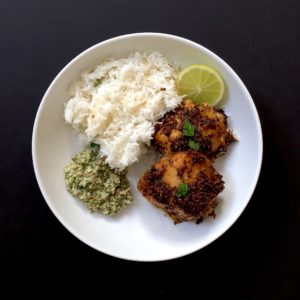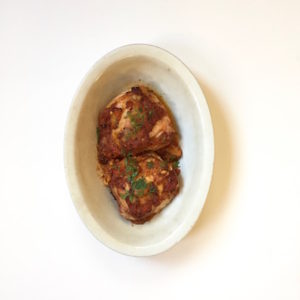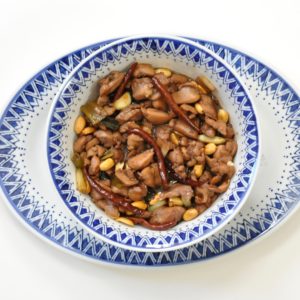Kitchen Kit and Singing Chickens
What follows is an unusually long post, and isn’t indicative of future writing. Given the holidays, I felt this was the time write about equipment, and perhaps take a risk with a longer piece. Feel free to skip to the end and check out the recipe for Chicken with Lemon and Garlic.
—
Sooner or later, anyone who writes about food is moved to discuss kitchen equipment.
Many cookbooks begin this way, their authors making suggestions ranging from realistic to laughably improbable. Naomi Duguid’s recipes generally require little more than a cast iron skillet and mortar and pestle.The Martha Stewart Christmas Cookbook assumes readers possess 48 tartlet pans, candy thermometers, and a baking stone. I once reviewed a cookbook whose author hawked Magimix blenders so relentlessly I suspected her a company rep.
Rest assured this isn’t a list of pots and pans, or a rummage through my kitchen cupboards. I began in that direction, quickly seizing up. Who am I to tell you how to furnish your kitchen?
Instead, this is a meditation on kitchen equipment, a broader examination of what Nigella Lawson calls kitchen kit. The tao of the kitchen, if you will.
Even if your kitchen is imperfect, it’s the one you’ve got. Prior to my current kitchen, whose lacks have spawned an entire blog, I worked in a kitchen whose four-burner electric stovetop achieved varying levels of heat, with the smallest burner reaching volcanic temperatures. As graduate students, my husband and I lived in an old apartment building whose ancient fuses blew constantly, rendering the oven useless. Our cooking got done using a crock pot, toaster oven, and electric skillet.
Notice the use of gadgetry. Many estimable cooks, Alice Waters, Jody Williams, and David Tanis among them, disdain kitchen electronics. Williams, calling herself an “old soul,” prefers her chef’s knife, fork, or spoon. “How would your grandmother make this?” she asks her chefs.

A reasonable query. Yet gadgets have their place in the kitchen, provided you know what they’re doing for you and why. Is the machine alleviating an otherwise mundane chore or painful burden? Is it freeing you to perform other cooking tasks? Or are you allowing it to rob you of agency?
To wit: for decades I avoided purchasing a food processor, managing nicely with a large knife, mortar and pestle, and an immersion blender. But when carpal tunnel syndrome, DeQuervain’s tendonitis, and shoulder impingement threatened my kitchen career, I capitulated.
Good kitchen equipment is expensive, often shockingly so.The single costliest item in my kitchen, a Staub six-quart cocotte, set me back $500. Unless one is an heiress or has lucked into a relative’s batterie de cuisine, outfitting a kitchen can take years. This is not reason to despair. Laurie Colwin correctly observes “it is perfectly possible to cook well with very little.” Good food results from care, patience, and intent. Quality ingredients never hurt. But cookware comes last in the equation.

Further, few home cooks need more than one $500 cocotte. Some may not need one at all. This brings us to an important point in equipment acquisition, a spot where personal wisdom is recent and hard-won.
Kitchens are much like wardrobes. At the bare minimum, everyone needs enough underwear and socks, a pair of comfortable shoes, and a few t-shirts. Most of us, at one time or another, have gone shopping for these mundane items only to return home bearing five-inch heels we’ll wear perhaps once, a foolish impulse buy for a life we don’t live. Meanwhile, we’re down to three pair of frayed undies.
It’s even easier to make this mistake in the kitchen, especially when drooling over enameled cast iron cookware and French bakeware. These wildly colorful pots, pans, and bakers are everywhere the interested cook looks—splashed across full-page magazine ads, cradling Boeuf Bourguignonne in favorite cookbooks, popping up in blogs we admire. Oh, those racecar reds, sunny yellows, azure blues! Oh, how easy it is, with a few dollars in hand, to buy that adorable mini-cocotte in Flame or that wee butter warmer in Cherry.
Once home, these items join the five-inch heels, seeing little use, for real life doesn’t call for mini-cocottes or butter warmers.
Only now, twenty-two years into home cooking, am I finally realizing the importance of heavy sheet pans, a good muffin tin, and a capacious cooling rack. Along with spatulas, bowls, and spoons, these admittedly pedestrian items see daily use in my kitchen. If they don’t make immediate appeals to the lizard brain, they shouldn’t have to. Quality cookware is its own reward. A well-constructed sheet pan means cookies with crisp bottoms and perfectly baked tops. It cleans up easily. Over time, this pan becomes a trusted friend in the kitchen.
This is not to say you need a muffin pan or cooling rack. Rather, just as you make a list before marketing, think carefully about potential kitchen purchases. What sort of cooking do you do? What foods do you enjoy? Is your cooking repeatedly stymied by lacking a specific piece of equipment? That’s what you need.
Know that your needs will change over time. The twenty-year-old cook and the forty-year-old cook have vastly different needs and desires, both in the kitchen and out. Who you cook for or with, you income, your health, your environment–all impact not only the foods you cook, but the equipment you’ll use to cook them. In the kitchen, in life: where you start isn’t necessarily where you finish.
Scarce few sweeping statements may be safely made about kitchen equipment. Buy the best you can afford: quality cookware will last a lifetime if properly cared for. Every cook benefits from a cast-iron skillet.
It is impossible to work in the kitchen without one excellent knife, whose sharp edge should be maintained, either by you or a professional.

Beyond that, what goes into your kitchen is up to you. Nobody, no matter how well meaning, should dictate such a personal decision. All people like me can or should do is offer the wisdom of our experience.
A final note. Even if yours is the most primitive of kitchens, you already posses the most critical kitchen equipment: your hands and your senses. Taste during all stages of the process. Learn to trust yourself. Even the finest cookware cannot compensate for a cook afraid to handle food or trust what she’s seeing, hearing, smelling.
Jacques Pepin, who recently celebrated his 80th birthday, wrote the following in Chez Jacques:
“As an apprentice, I learned to recognize when a chicken was cooked just by hearing it in the oven. We would say ‘le poulet chante’ or, ‘the chicken is singing.’”
It wasn’t my intention to include a recipe here, but Chicken with Lemon and Garlic presented itself. This is a nice dish to make after holiday excess, though we don’t save it for that–in truth, we eat this dish, or variations thereof, so often that giving a recipe was challenging.
Like most of what I cook, Chicken With Lemon And Garlic is forgiving. This dish has tremendous leftover potential as well, though it’s a running joke chez IK that no matter how much I make, we manage to devour it all.
Try using the lemony cooking juices to cook your greens, rice, or couscous.
Chicken with Lemon and Garlic
Yield: 2-3 servings
cook time: 90 minutes
1 1/2 pounds (approximately 3-4 pieces) bone-in, skin-on chicken thighs, organic if possible
2-3 small lemons, organic if possible, well scrubbed, quartered
garlic cloves, as few or many as you like
liquid for the baking pan: water, broth, white wine, Vermouth, or a combination
salt
Marinate the chicken. In an oven-safe ceramic, glass, or enameled cast-iron baking pan, squeeze the quartered lemons over the chicken thighs, tossing the spent quarters in with the chicken. Add about a teaspoon of salt. Refrigerate, covered with foil or plastic wrap, 1-24 hours. Often I prepare this the night before, leaving the chicken overnight and all day.
Allow the chicken and the pan to come to room temperature. Putting a fridge-cold pan into a hot oven may shatter it: if for some reason you must cook the chicken fridge-cold, transfer it to another baking pan and add about 15 minutes cooking time.
Preheat the oven to 325F.
Add liquid to come about halfway up the sides of the chicken. Add the garlic. I toss it in unpeeled. It bakes in the oven, becoming soft and sweet.
If you prefer crisp skin, be sure your thighs are skin-side up.
Bake the chicken for an hour and fifteen minutes before checking for doneness. Listen for it to “sing”–it will sizzle and crackle. Or breathe deeply: a cooked chicken smells done. Do check with a fork and knife: the juices should run clear, or, if the bird is organic, look just slightly pink but NOT bloody. Meat should be fork tender and pull easily from the bone. Skin should crunch and break under pressure. It may need 15 more minutes cooking for total of 90 minutes.
Note: Vary the seasoning by adding fennel, paprika, coriander, and hot pepper flakes.
Serve your finest china or cheapest melamine.

(RIP Lemmy.)




